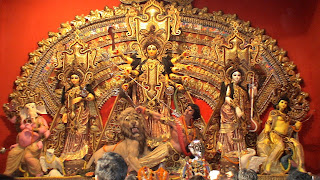During my recent visit to Kolkata there were many images that caught my attention since these are the views that I would be able to find in the lazy, laid back city of joy - Kolkata. Most of them have gained significance for me since they symbolise the soul of the Kolkata I knew during my growing up years and are now becoming very rare and on the verge of extinction.
The first one is the architectural style of the houses. Such houses can still be seen in North Kolkata and are a delight to see. They symbolise the old traditions of typical West Bengal.

They have become a rarity in most parts of Kolkata since they have been replaced by modern looking high rise blocks of apartments which look and feel the same irrespective of the city that they are found in. What stands out in this house are the large verandah in front of the house and the 'Khorkhori-tola' windows. These types of windows can be found in a few houses in North Kolkata these days. The speciality of these windows are that one can simply lift the blinds to let fresh air and sunlight come into the room without openeing the window thereby providing a sense of security.
Trams are the first motorised form of transport that was introduced in the city of Kolkata many centuries ago. Although the streets of Kolkata now witness fast paced cars, the metro and other superior means of motorised communication, the tram remains it's link to its past.

Trams are a means of transport that can only be found in the city of Kolkata in India and the government showed its interest in preserving its heritage by laying down new tram lines across the city worth crores of rupees. One of the drawbacks of this kind of transport system is that tram lines have to be laid down across the city for them to ply. They look something like railway tracks and play havoc with the roads of the city. Another challenge is the speed of commuting which is very slow. Still the sound of the bell of the tram which substitutes the horn of the modern day vehicle is always a delight to hear.
The hand pulled rickshaw also is typically found in the state of West Bengal. Often, that provides the only means of income to a family. Although the cycle pulled rickshaw is popular in the other parts of India, it has not made its presence felt in Kolkata.
The rickshaw puller often runs bare foot across the streets pulling his rickshaw behind him all because he cannot afford to buy a decent pair of shoes. Instead of horns they have use bells or verbally call out to the pedestrians to make way for him. With little to eat and the long hours that he needs to work to provide for his family, it is a very tough life for him. Each journey of 3-4 kilometers will probably earn him Rs 7 to Rs 10. Only of he makes 10 such journey in the entire day will he probably earn enough to feed his family for the day.

For someone who covers 30 to 40 kilometers per day to earn Rs 70 to Rs 100 it is indeed a very hard way of life. And with whatever he earns he has to support a family of 7-8 people. No wonder they can neither afford to send their children to school nor provide themselves with quality medical care. And they continue to inhabit the lower strata of the society.... with no means of breaking out of the vicious cycle.























